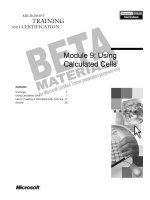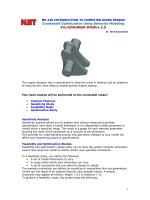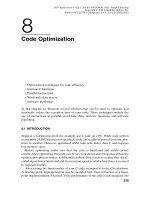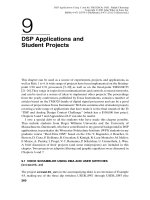Tài liệu Chapter 9 Using Telephone and Cable Networks for Data Transmission pptx
Bạn đang xem bản rút gọn của tài liệu. Xem và tải ngay bản đầy đủ của tài liệu tại đây (884.83 KB, 37 trang )
9.1
Chapter 9
Using Telephone
and Cable Networks
for Data Transmission
Copyright © The McGraw-Hill Companies, Inc. Permission required for reproduction or display.
9.2
9-1 TELEPHONE NETWORK
9-1 TELEPHONE NETWORK
Telephone networks use circuit switching. The
Telephone networks use circuit switching. The
telephone network had its beginnings in the late
telephone network had its beginnings in the late
1800s. The entire network, which is referred to as the
1800s. The entire network, which is referred to as the
plain old telephone system
plain old telephone system
(
(
POTS
POTS
), was originally an
), was originally an
analog system using analog signals to transmit voice.
analog system using analog signals to transmit voice.
Major Components
LATAs
Signaling
Services Provided by Telephone Networks
Topics discussed in this section:
Topics discussed in this section:
9.3
Figure 9.1 A telephone system
End
offices
Local loop
Trunk
Tandem
offices
Regional offices
Trunk
• • •
9.4
Intra-LATA services are provided by
local exchange carriers.
Since 1996, there are two
types of LECs: incumbent local
exchange carriers and competitive
local exchange carriers.
Note
9.5
Figure 9.2 Switching offices in a LATA
9.6
Figure 9.3 Point of presences (POPs)
9.7
The tasks of data transfer and signaling
are separated in modern telephone
networks: data transfer is done by one
network, signaling by another.
Note
9.8
Figure 9.4 Data transfer and signaling networks
9.9
Figure 9.5 Layers in SS7
9.10
9-2 DIAL-UP MODEMS
9-2 DIAL-UP MODEMS
Traditional telephone lines can carry frequencies
Traditional telephone lines can carry frequencies
between 300 and 3300 Hz, giving them a bandwidth of
between 300 and 3300 Hz, giving them a bandwidth of
3000 Hz. All this range is used for transmitting voice,
3000 Hz. All this range is used for transmitting voice,
where a great deal of interference and distortion can
where a great deal of interference and distortion can
be accepted without loss of intelligibility.
be accepted without loss of intelligibility.
Modem Standards
Topics discussed in this section:
Topics discussed in this section:
9.11
Figure 9.6 Telephone line bandwidth
9.12
Modem
stands for modulator/demodulator.
Note
9.13
Figure 9.7 Modulation/demodulation
9.14
Figure 9.8 The V.32 and V.32bis constellation and bandwidth
9.15
Figure 9.9 Uploading and downloading in 56K modems
9.16
9-3 DIGITAL SUBSCRIBER LINE
9-3 DIGITAL SUBSCRIBER LINE
After traditional modems reached their peak data rate,
After traditional modems reached their peak data rate,
telephone companies developed another technology,
telephone companies developed another technology,
DSL, to provide higher-speed access to the Internet.
DSL, to provide higher-speed access to the Internet.
Digital subscriber line
Digital subscriber line
(
(
DSL
DSL
) technology is one of the
) technology is one of the
most promising for supporting high-speed digital
most promising for supporting high-speed digital
communication over the existing local loops.
communication over the existing local loops.
ADSL
ADSL Lite
HDSL
SDSL
VDSL
Topics discussed in this section:
Topics discussed in this section:
9.17
ADSL is an asymmetric communication
technology designed for residential
users; it is not suitable for businesses.
Note
9.18
The existing local loops can handle
bandwidths up to 1.1 MHz.
Note
9.19
ADSL is an adaptive technology.
The system uses a data rate
based on the condition of
the local loop line.
Note
9.20
Figure 9.10 Discrete multitone technique
9.21
Figure 9.11 Bandwidth division in ADSL
9.22
Figure 9.12 ADSL modem
9.23
Figure 9.13 DSLAM
9.24
Table 9.2 Summary of DSL technologies
9.25
9-4 CABLE TV NETWORKS
9-4 CABLE TV NETWORKS
The
The
cable TV network
cable TV network
started as a video service
started as a video service
provider, but it has moved to the business of Internet
provider, but it has moved to the business of Internet
access. In this section, we discuss cable TV networks
access. In this section, we discuss cable TV networks
per se; in Section 9.5 we discuss how this network can
per se; in Section 9.5 we discuss how this network can
be used to provide high-speed access to the Internet.
be used to provide high-speed access to the Internet.
Traditional Cable Networks
Hybrid Fiber-Coaxial (HFC) Network
Topics discussed in this section:
Topics discussed in this section:









